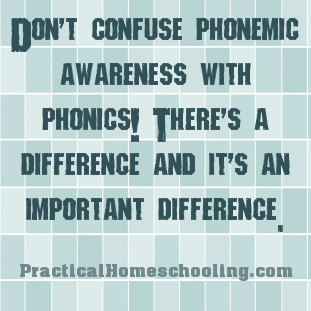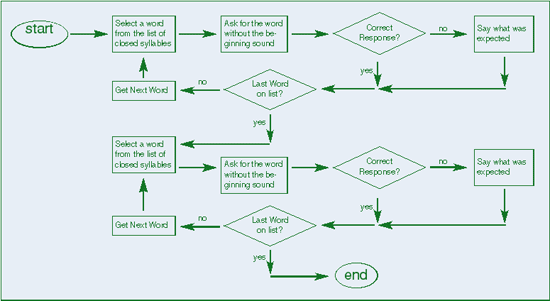 Please don't confuse phonemic awareness with phonics! There's a difference and it's an important difference.
Please don't confuse phonemic awareness with phonics! There's a difference and it's an important difference.
Consider a child who is just starting to read. Assume that the child has a good speaking vocabulary, knows that those marks in a book are called letters, can identify and name the letters. (See my piece in issue #68 on the Communication Code Alphabet (CCA) for my biased opinion about this.) At the "reading readiness" level, the child can probably write his/her name in block letters and recognize it when it exists on a paper.
What we'd like to have happen is for the learner to go through a pleasant experience that involves (not necessarily in this exact sequence):

- Be able to recognize and identify the 26 characters we call letters.
- Learning that there are sounds associated with individual letters.
- Knowing and demonstrating that sounds combine to make words, even nonsense and words previously unknown.
- Knowing that some letters make more than one sound.
- Knowing that some sounds can't be made by only one letter, so letters get combined to make those sounds.
- There are too many different combinations to learn rules for, so some of the combinations of letters (words) must be memorized.
- Words go together in certain ways to express thoughts.
- If one can read, one can grow intellectually and have great experiences.
- If one cannot read, his/her options in life are limited.
In this piece, I'm going to talk only about items 1, 2, and 3. Phonemic awareness is an ability to master items 2 and 3. Let's see how we might go about teaching it.
First, a little side trip into the writing conventions on linguistics: linguists have established a standard phonetic alphabet. It's called the International Phonetic Alphabet (IPA). It's a set of symbols that will allow any linguist to read a phoneme string written by another linguist and be able to pronounce it the way the writer intended. The IPA is somewhat akin to the pronunciation guide in your dictionary. The problem with using the IPA is that the symbols aren't on my keyboard. And even if they were, I wouldn't use them because they're a pain to write and read. (Check out the wikipedia.org article on "international phonetic alphabet" and you'll see what I mean!) So I'm going to do what many reading educators do, I'll write what makes sense to me and hope that you can read it.
Okay, back to phonemic awareness. It has been shown by much research that the most common identifiable factor in non-readers, poor readers, and those who don't enjoy reading, is their lack of phonemic awareness. Without phonemic awareness, it is very difficult to read a word the reader hasn't seen before.
One indication of literacy is the ability to read a word that the reader has never seen before.
For beginners we commence with closed syllables. I like the word cat. I've yet to meet a child who did not know the word and what it represents. To express the pronunciation of cat, I'll write /k/ /aa/ /t/. The word cat has nice properties for beginning readers; it begins with a consonant sound, has a short vowel sound in between, and ends with a consonant sound. Experts call it a closed syllable. Some other nice closed syllables are: rat, sad, back, lack, bed, sell, let, men, net, fit, pit, lit, sit, rob, lock, cot, not, bug, rug, mug, tug, and mud. If you can agree that each of those example words comprises three sounds, you have demonstrated phonemic awareness.
With a beginning reader, I ask her to say cat. If she says it clearly and crisply, I'm encouraged. If she says /k/ /aa/ (without the /t/), as in baby talk, I know some speaking or listening remedial work is in order, but that's not our topic for this issue.
I then ask her to say cat without the beginning sound. If I hear a /aa/ /t/, I'm encouraged. If I don't get /aa/ /t/, I say, "What I was expecting was /aa/ /t/; that's cat without the beginning (first) sound."
Then I'll try another word: "Say bat without the /b/ sound." If I get /aa//t/, I'm encouraged. I will proceed with many of the words from that list above. If we get lots of appropriate responses, this child is demonstrating one part of phonemic awareness.
After some practice with the "say ____ without the first sound" exercise, I go to some "say ____ without the ending sound" practice. A flow chart of the process is on the previous page. Check it out and you will be able to see which of your children has true phonemic awareness.